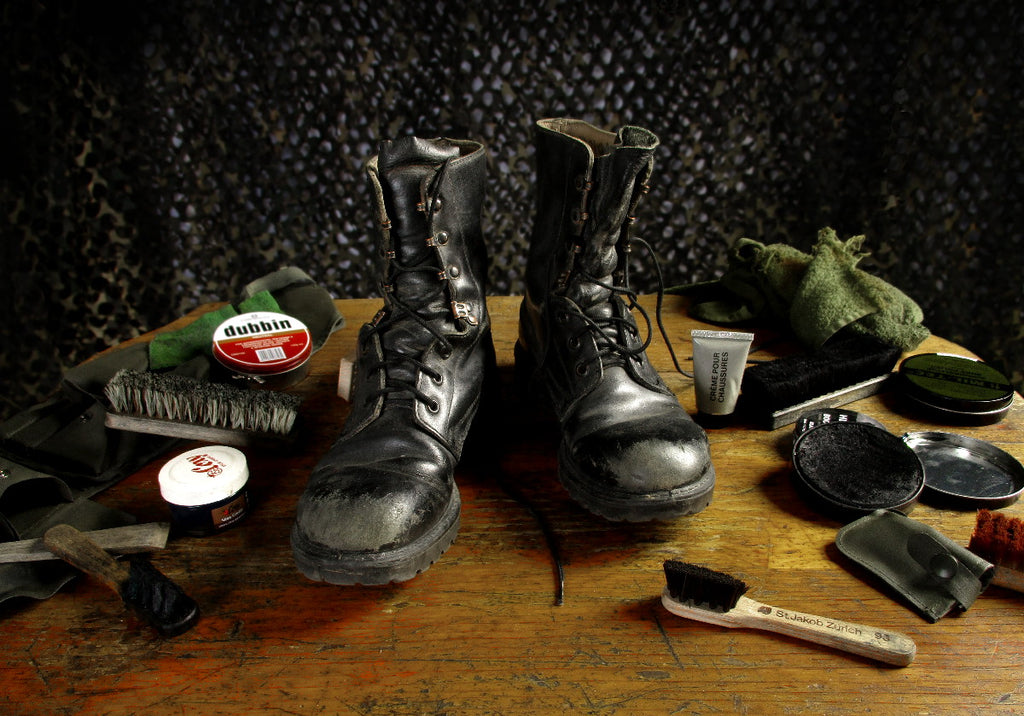
Your boots will treat you well if you treat them well. Good boot care keeps them waterproof, stops them from falling apart, and stops them smelling awful.
Clean your boots
This should be done after every trip. It is essential to have clean boots before you do any treatment on the material, and it also protects them while they are in storage. Having dirt caked onto your boots can dither dry out the outer surface and cause it to crack, or it can cause them to deteriorate from being exposed to dampness for long periods of time.
The process is pretty much the same whether your boots are leather, canvas, or rubber (but don’t wash suede with water). Start by getting all the gunk off the soles. An old toothbrush is great for getting in between the chunks on the grip.
Next, remove the laces and use warm water and a damp cloth to get off as much dirt as you can from the exterior of the boots. Pay special attention to the seams, the crinkles and grooves in the tongue, and the groove where the exterior material of the boot meets the sole. If you can’t get it all with a cloth, you can use a regular shoe-cleaning brush. You can also go at it with a toothbrush, but be gentle; you don’t want to damage and scuff your boots.
Wait for your boots to dry before applying any treatment.
Leather care
Treating your leather boots will keep the seams from leaking and prevent the leather from cracking when it gets too dry.
Your local outdoors store should be able to recommend a treatment product. They are usually leather creams or wax, and vary slightly depending on what type of finish your boot has. If you really have no idea what to use, go for a wax product – it might slightly darken the colour of your boots, but it will definitely treat the leather and keep the water out.
Apply creams with a cloth. You can also use a cloth to apply soft wax products, but you’ll find it’s easier to do with your fingers, because your body heat melts the wax a little and it becomes easier to spread.
Be systematic: start with one section of the boot and work your way around. Really squish the product into the seams (this is where water will get in if you’re not careful). Don’t forget about the tongue.
Don’t be afraid to use plenty of product, but make sure you rub it in well. There shouldn’t be globs of product visible on the boots when you’re done.
Suede care
If you’re not particular about how your suede boots look, you can wash them with water, but the colour will likely go blotchy and the surface won’t quite be the same.
If you want to keep that pristine look, brush the dirt off with a soft bristled shoe-cleaning brush. Remove stains by dabbing with a cloth with a little bit of white vinegar or using a professional suede cleaning product.
Before taking your suede boots outdoors, you should treat them with a waterproofing spray. These are cheap and easy to apply.
Remove the laces. Spray the treatment over the boots, being careful to get all of the seams and grooves. When you’re finished, the suede should be wet from the spray, but not soaking or dripping. Place the boots outside in a dry area to dry out (the smell of the spray will get to your head if you leave them inside).
Canvas care
Canvas boots can be washed in a regular washing machine if you don’t mind the noise, but they’ll last a bit longer if you wash them by hand.
Use warm soapy water (the same detergent you’d use in the washing machine) and scrub them with a cloth or brush. Rinse the soap out of them and leave them to dry with some newspaper stuffed inside. As with drying any footwear, you can put them in a warm place (outside in summer, or near the fireplace or heater in winter) but make sure they aren’t too close to the heat, or the fabric may warp and the glues and rubber may come undone.
Smelly boots
You’ve been in the bush for a week. Your boots have been damp most of the time. You’ve been rotating between the same three pairs of socks. Now you’re home and you can’t put your boots in the closet with you other stuff because they reek. What do you do?
The first thing is to remove and clean the inner soles. You can give them a good scrub by hand or throw them in the washing machine with the rest of your outdoors clothes.
Next, remove as much dirt as you can from the lining of your boots using a dry soft brush or cloth, and clap your boots together upside-down to shake out the dirt. If they’re particularly bad, you can use a damp cloth, but make sure to dry them out immediately afterward, or they’ll just end up smelling worse.
There are plenty of deodorising products out there. Some of them are just cover-ups that won’t actually remove the smell from your boots. This is usually the case with sprays and oils. Powders such as Gran’s Remedy will actually soak up the smell, and a good cheap option is to sprinkle in some baking soda and leave them overnight.
Another good way to kill off stink-causing bacteria is to de-lace your boots, open them up and leave them in the sun for a few hours. The UV light kills bacteria, and the fresh outside air won’t do them any harm either.


